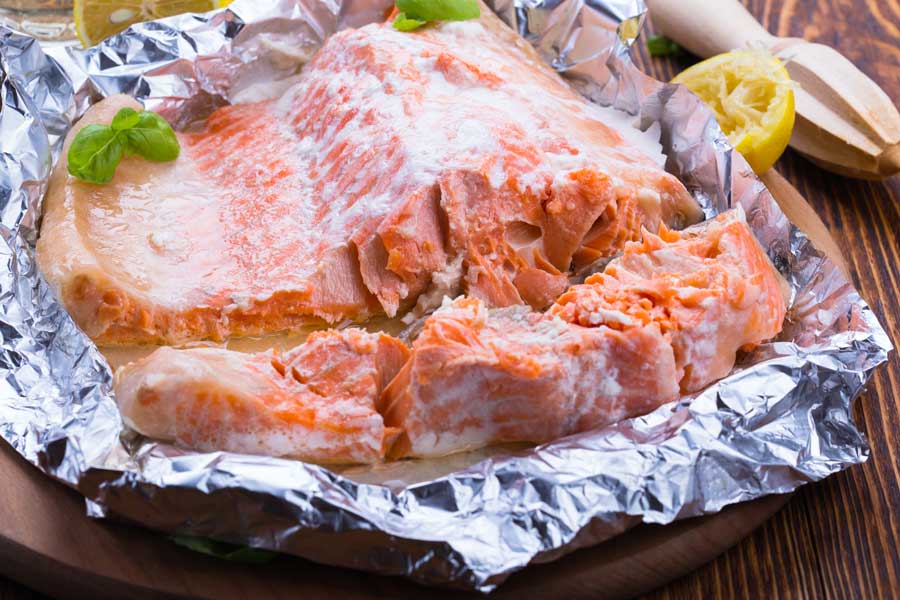
How to Poach Salmon
What is poaching?
Poaching is a gentle, low-temperature, moist-heat method of cooking, either on a stove top or in the oven. It’s most often used to cook delicate proteins such as fish. Poaching usually involves a liquid, but because wild salmon is so naturally moist and full of healthy omega-3 fats, you can actually poach it just in its own internal juices.
Why poach wild salmon?
We love this elegantly simple and incredibly flavorful way to poach wild salmon in the oven. It yields tender, flaky, delicious fish. (You can also poach salmon on the stove top, but that involves a bit more monitoring, so you’ll appreciate the simplicity of this hands-off approach.) One of healthiest cooking methods, poaching retains the nutrients in your fish, enhances its natural flavor, and provides a delicious and convenient solution for an easy midweek meal.
Use foil to seal in the goodness
An easy way to poach your salmon is to wrap it in foil. Aluminum foil has a high thermal conductivity index, so it disperses the heat evenly throughout your fish and seals in all the natural liquids, fats and flavors. (Parchment paper may also be used, but because it can’t be sealed as easily and lacks the heat-disbursement quality, we prefer foil.)
Choose your salmon carefully
Choose a high-quality wild-caught Sockeye salmon fillet or already-cut salmon portions, deboned and with scales removed from the skin. Thaw overnight in the refrigerator, let sit at room temperature for a short time, and thoroughly pat dry. If cooking a fillet, you can wrap it whole, or cut it into three to five serving-size portions and wrap each individually. Leave the skin on to retain the healthy omega-3 fats, and to support all those tasty juices.
Preheat oven to 250 ℉.
How to wrap
Tear off foil large enough to create wrappings that will completely surround the salmon and can be folded and pinched closed to seal in juices. If poaching the filet whole, tear off two pieces of foil so they are eight to twelve inches longer than the length of the salmon. Double fold the long seams together and pinch tight. Then tear off a third piece and place that on top of the seamed foil. Though some poaching directions will say to spray with non-stick cooking spray, to rub with butter or to place a piece of parchment paper under the fish, we’ve found none of these is really necessary. The poaching juices make the fish easy to remove, with or without the skin.
Sprinkle your salmon with salt on both sides. Place salmon on foil, skin side down, and lay thin lemon slices over the top of the salmon. (Salt and lemon draw out the juices from the fish, helping it poach naturally.) Top with patties of butter. No other liquid is necessary. You’ll find this minimalist approach easy and tasty. Foil and fish are fun, fearless and foolproof, we like to say!
Experiment with flavor variations
Salmon is endlessly adaptable. Lemon, salt and butter make a tasty meal, but before sealing up your fish, you may want to jazz it up with whatever you have on hand:
- Sprinkle with soy sauce, apple cider vinegar, balsamic vinegar, fresh squeezed lime juice or white wine.
- Add herbs - sprigs of parsley, cilantro, dill or thyme.
- For a sweeter taste, drizzle with honey or maple syrup, or crumble brown sugar on top.
- For pungency, add onions, garlic, ginger or horseradish.
If doing smaller, individual packets, this would be a great time to experiment with flavor combinations and different kinds and amounts of liquids. Custom create for each family member, if you’re feeling ambitious!
Of the four variations we recently tried, our two favorites both involved brown sugar. (We like sweetness!)
- Salt, butter, sliced onions and brown sugar. It all caramelized wonderfully!
- Salt, barbecue sauce, lime juice and brown sugar. Smoky, sweet and spicy!
Place in oven to poach
After adding your toppings, seal your packet(s) tightly and place in a baking dish. Poach your salmon at 250 ℉ or 45 minutes to one hour, depending on thickness, but check at 25 minutes. Check for doneness by gently inserting a fork into a fatty white seam at the thickest part of the fish. If a wiggle of the fork causes the fish to easily separate into flakes, it’s done. If not, reseal your packet and continue baking. Your fish need not be completely pink throughout - a little bit of translucency is OK. Err on the side of caution and remove if the salmon is just starting to flake. On a meat thermometer, 120 ℉ is on the just-getting-done path. We prefer to remove it at that temperature, but others like it more done, and let it bake to 140 ℉.
Serve
Serve with or without the skin. Many consider the skin a delicious addition to the dish, and of course it’s full of nutrients. Pour those aromatic juices onto your fish, or even onto your vegetable dish - or save them for heating up leftovers. Lemony hollandaise sauce is a nice finishing touch.
Leftovers
Poached salmon is delicious when eaten cold. But if you prefer it warm, reheat in oven, covered with foil, at 275 ℉ for about 10 minutes. You can also reheat in the microwave, covered, on 50% power.
Perfectly poached fish will please your palate and your people!
